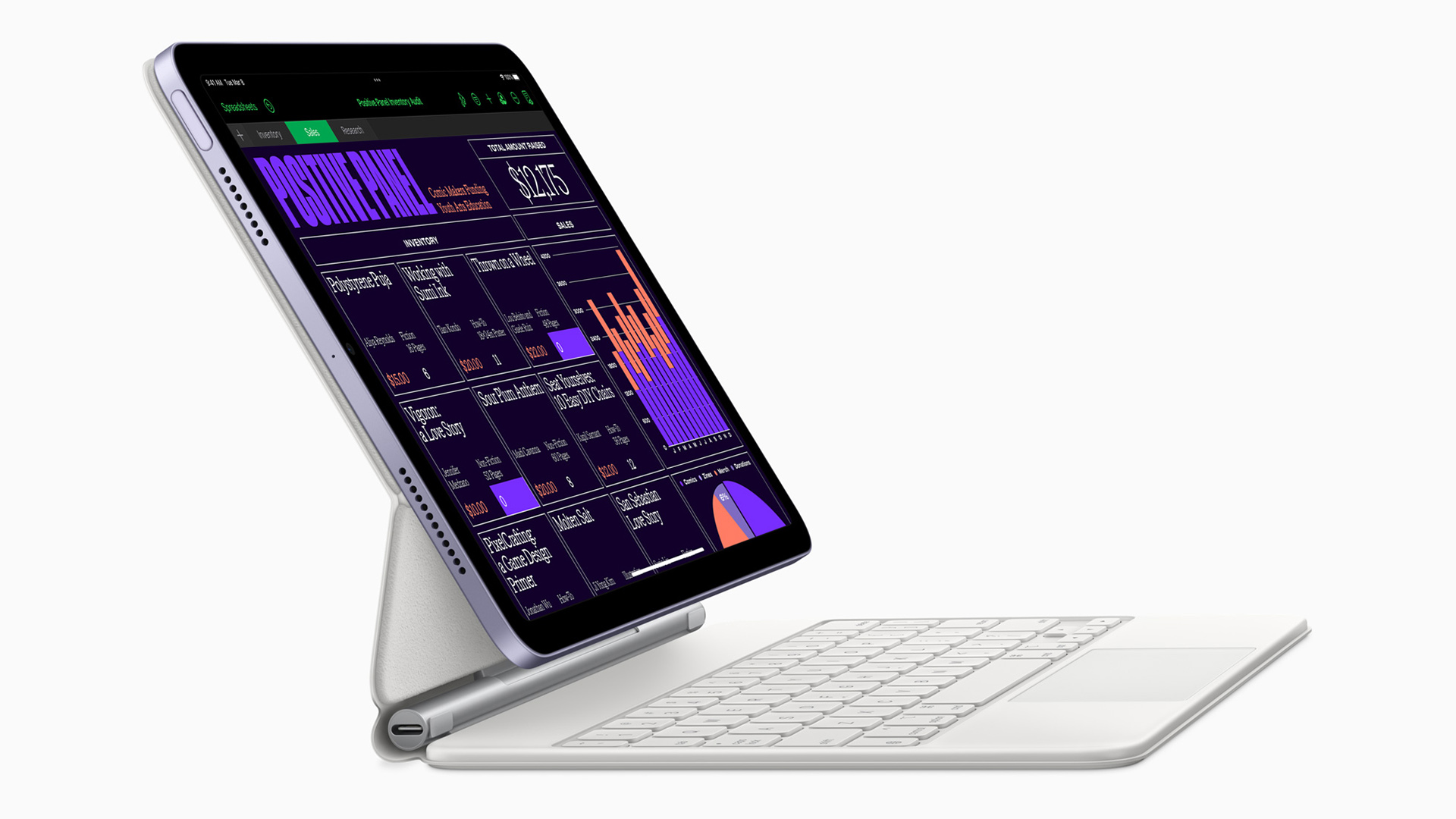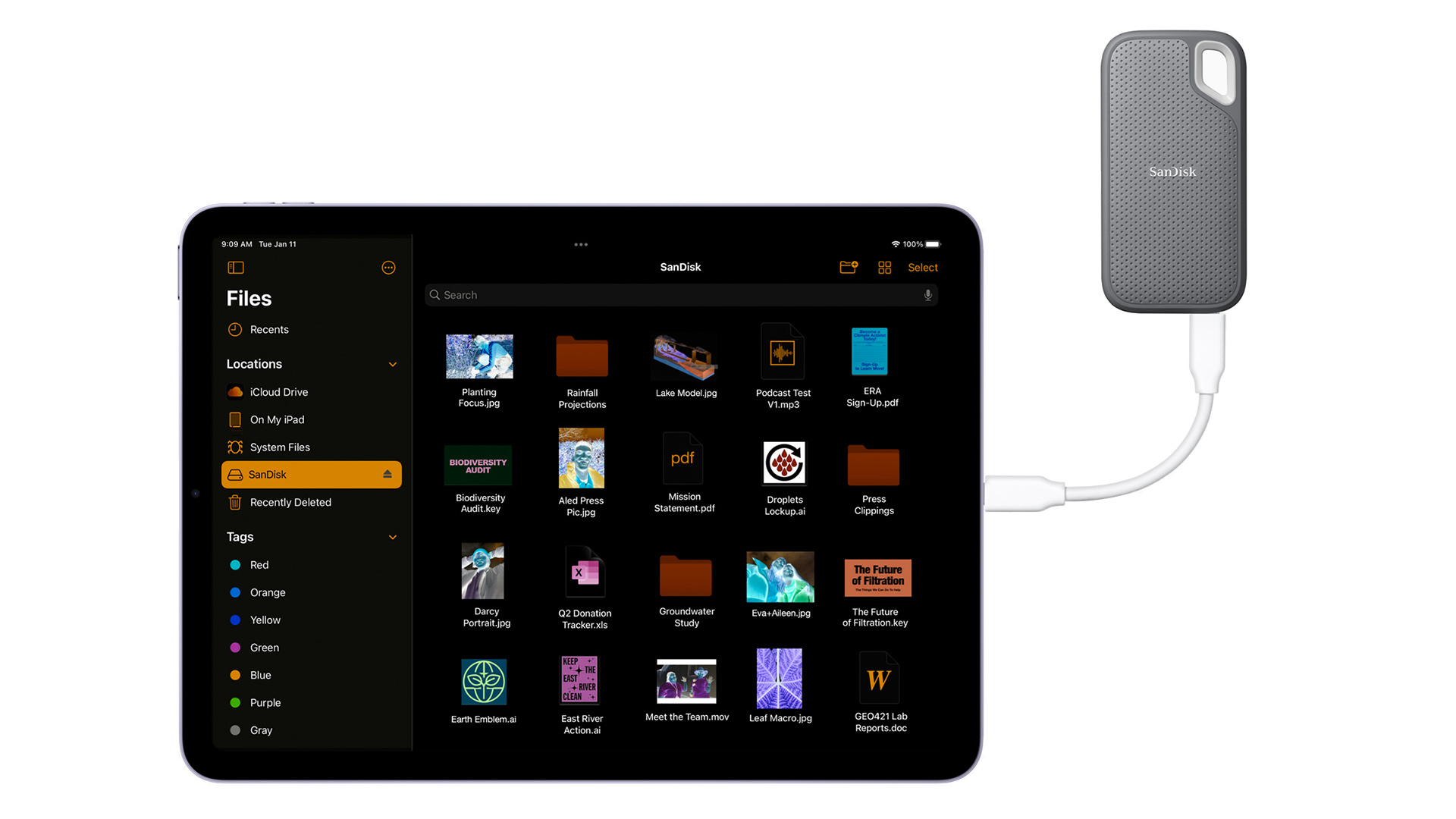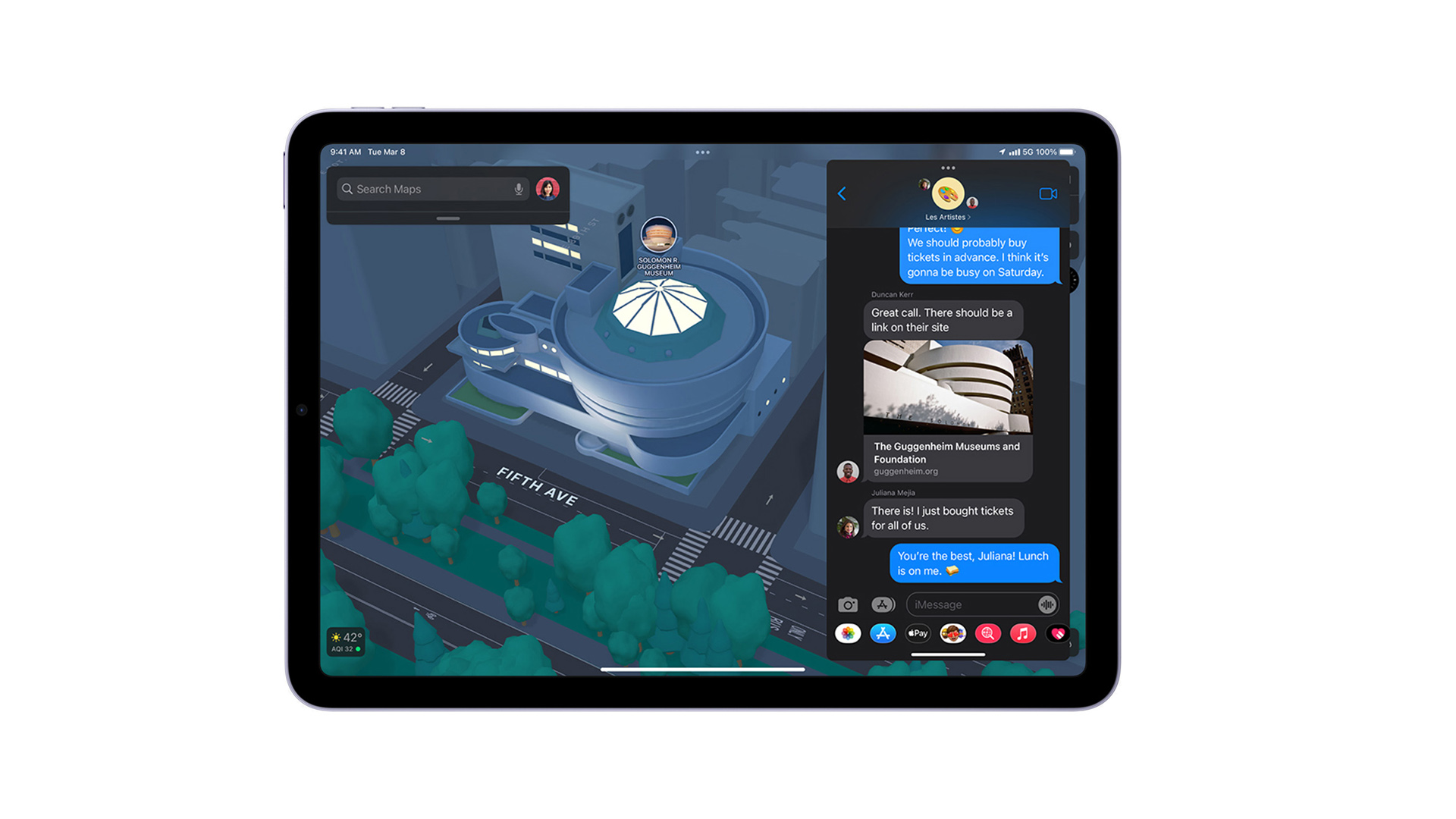What Hi-Fi? Verdict
The same picture and sound as before, but with vastly more power under the skin
Pros
- +
Still a lovely design
- +
Extraordinarily powerful
- +
The same great picture and sound
Cons
- -
Poor placement of front camera
- -
Nearly no change to AV performance
Why you can trust What Hi-Fi?
The iPad Air (5th Generation) – aka the iPad Air 5 and iPad Air 2022 – is a big deal. That’s almost entirely because, in a move predicted by next to no one, Apple has decided to cram into its supremely slim and lightweight chassis the awesomely powerful M1 processor.
The intention is clearly to make the Air a sort of iPad Pro Lite that will satisfy the creative types for whom the full-fat Pro models are expensive overkill.
But what’s in it for those of us whose interests lie primarily in the consumption of the creative endeavours of others? According to the spec sheet, the screen and speakers are the same as those that adorned the iPad Air 4. So are there undocumented changes in these departments or is this simply the same AV experience as before, and would that be such a bad thing?
Price
The new iPad Air 5 (2022) price starts at £569 / $599 / AU$929. Somewhat surprisingly, that means the new model is £10 cheaper in the UK than the iPad Air 4 was at launch, while in Australia it's slightly more expensive. The price in the States has stayed the same.
That price will get you a 64GB wi-fi-only model. The 256GB wi-fi-only model will set you back £719 / $749 / AU$1159.
Adding cellular to whichever storage option you choose will add a cool £150 / $150 / AU$230 to the price.
Design

The iPad Air 5 is available in five colours, just as the iPad Air 4 was, but, Space Grey aside, they're all slightly different to the colours they replace: 'Silver' is now 'Starlight', which appears to be a slightly less stark and cold hue; 'Rose Gold' is now a slightly subtler 'Pink'; 'Sky Blue' is now a richer, more vibrant 'Blue'; and 'Green' has now been replaced by 'Purple'. We thought the green finish of last year's model was rather lovely but perhaps buyers didn't agree. Green can't be that unpopular though, as Apple has just launched it as a new option for the iPhone 13 and iPhone 13 Pro phones.
The latest hi-fi, home cinema and tech news, reviews, buying advice and deals, direct to your inbox.
Colours aside, the design of the iPad Air 5 is essentially identical to that of the iPad Air 4, with the only difference on the spec sheet being a 3g (0.02lb) increase in weight. Dimensions remain 248 x 179 x 6.1mm (9.7 x 7 x 0.2 inches), and that makes this a very svelte proposition. As before, there's no home button and only slim bezels, with the screen very much taking centre stage.
As before, there are speakers on the top and bottom edge when the tablet is held in portrait mode, which means they work in a traditional left and right stereo configuration when it’s in the movie-friendly landscape orientation. The single-lens camera is the same as before, too, at least in terms of hardware, and it sticks out from the same top-left corner of the tablet’s rear, just as it did on last year’s iPad Air 4.
The front-facing camera has had an upgrade though, from 7MP to 12MP, but it’s still fairly well hidden in the black bezel along one of the iPad’s shorter edges. That camera placement is actually a missed opportunity, as it means that the camera is quite a long way off to the side when you’re using the tablet for video calls in the preferable landscape mode. This uncharacteristically poor design decision by Apple means it can appear to the person on the other end of the call as if you’re trying to avoid eye contact.
Features

The big news on the features front is that the new iPad Air is powered by Apple’s super-fast M1 processor, which features in the company’s desktop Macs and MacBooks, as well as the iPad Pro (11-inch and 12.9-inch versions). In short, this is now the most affordable M1-powered product you can buy and, according to Apple, that makes it 60 per cent faster than the iPad Air in terms of CPU performance, and twice as powerful from a graphics perspective.
So why has Apple decided to pack a Pro-level processor into arguably its most lifestyle-oriented iPad? Seemingly to increase its credentials as a productivity and creativity device so that it can bridge the gap between the fairly media consumption-oriented iPad and iPad Mini and the heavyweight Pro models. One suspects that Apple noted a lot of iPad Air 4 users who were making use of its Magic Keyboard and Apple Pencil 2nd Generation compatibility and decided to give them the performance to match their ambitions.
The M1 isn’t only powerful, though – it’s also efficient, so battery life remains around 9-10 hours of constant use despite the performance upgrades.

Screen size 10.9in
Resolution 2360 x 1640 (264ppi)
Storage 64GB / 256GB
Finishes x5
Battery life 10 hours
Cameras 12MP rear / 12MP front
Dimensions (hwd) 25 x 18 x 0.6cm
Weight 461g
Of course, our prime concerns are the picture and sound quality and the specs suggest that nothing has changed here. Apple’s own data sheet indicates that the new iPad Air has the same two-speaker sound system as its predecessor, as well as the same display, with no changes to size (10.9 inches), resolution (2360 x 1640), pixel density (264ppi) or peak brightness (a quoted 500 nits).
It's always a shame when specs stay static across device generations, but the iPad Air 4 was a superb video playback device so it’s little surprise that Apple hasn’t sought to make big changes here.
Picture

Playing It in 4K Dolby Vision from the Apple TV app, there’s an extraordinary degree of similarity between the performances of the new iPad Air and its predecessor. And we do mean extraordinary: it’s extremely rare to see this level of consistency between two samples of the same device, let alone from one generation to the next.
While it might seem disappointing that there’s been no obvious upgrade here, there’s simply nothing to complain about in the picture quality. The image is supremely authentic and natural, with an unquestionable colour balance, oodles of detail and crisp definition. Motion is handled adeptly without any hint of active processing and blacks, while not OLED-inky, are plenty deep enough and packed with detail. There’s a satisfying HDR punch to the sundrenched exterior scenes, despite the 500 nits limit to the brightness, and plenty of dramatic contrast in the scenes that take place in the terrifying tunnels beneath the cursed town.
Interestingly, it’s when we switch to 1991’s Cape Fear, delivered in HD and standard dynamic range, that the new iPad Air produces a better picture than the outgoing model. There are broad, familial traits, from the cinematically warm but natural colour balance to the clean, controlled handling of the comparatively low resolution source material, but the new model is noticeably brighter, not only in obvious highlights such as the lights of a diner and the sparkle from a piece of jewellery, but across the whole image, which is brighter and punchier without looking exaggerated. This is an image that simply pops from the screen that little bit more, drawing you even more effectively into the action.
These characteristics carry over when you switch to Blockers in standard HDR10, suggesting that the consistency offered across the two devices when playing Dolby Vision is down to the outgoing model’s existing adherence to the format. With SDR and standard HDR, though, Apple has found room for improvement, increasing impact.
In summary, this is the best tablet picture performance made just a little bit better when viewing non-Dolby Vision content.
Sound

The changes in the audio department are even more slight, to the extent that you’d be very hard pressed to hear any difference at all. Again, though, that’s something about which it’s hard to complain, because the iPad Air was already an excellent-sounding tablet.
While it takes a bit of effort to teach yourself to hold the iPad in landscape without blocking the speakers, it’s effort worth making, as the side placement enables the Air to produce an impressively open and spacious sound that’s surprisingly involving with music and a really atmospheric boon to movies. We’re obviously not talking about sound that wraps around you, but the degree to which effects stretch beyond all four sides of the tablet is very impressive and very enjoyable.
There’s plenty of punch and detail, too, and enough dynamic range to deliver a surprising amount of drama. Bass doesn’t extend incredibly deep, as you’d expect, but neither is the delivery lightweight, and the bass that is there is tuneful and controlled. It is worth mentioning here that the tablet does vibrate a fair bit when pushed to high volumes, though.
Of course, hearing the iPad Air at its best involves connecting a pair of headphones. To go wired and you’ll need to invest in a USB-C headphones adapter – the official Apple one will set you back £9 / $9 / AU$15. Plug that into a pair of Grado SR325x cans and the sound is fabulously clean, punchy and energetic. We’ve long applauded Apple’s dedication to neutral, balanced sound, and the new iPad Air doesn’t deviate from that approach. This is all about hearing your music (and movies) as intended, without overt exaggeration or colouration, and that’s just how it should be.
Verdict

While the iPad Air 5th Generation is undeniably an improvement over the iPad Air 4, its key upgrades are to its processor and front-facing camera. Those upgrades are each great in their own right, but for us what really matters are the picture and sound performance, and in these areas it’s pretty much business as usual.
There’s nothing wrong with that, though, as the iPad Air is supremely talented in these areas and more or less untouchable by other tablets in its price range. There’s an argument that the standard iPad is the better performance-per-pound proposition for the pure content consumer, but the new Air is the model to go for if you can afford it.
SCORES
- Picture 5
- Sound 5
- Features 5
MORE:
See all the What Hi-Fi? Award 2022 winners
Also consider the Apple iPad (2021)
Read our review of the Samsung Galaxy Tab S7 FE
Check out our Apple iPad Pro 12.9 (2021) review
These are the best tablets 2022: cheap to premium tablets for movies and music
What Hi-Fi?, founded in 1976, is the world's leading independent guide to buying and owning hi-fi and home entertainment products. Our comprehensive tests help you buy the very best for your money, with our advice sections giving you step-by-step information on how to get even more from your music and movies. Everything is tested by our dedicated team of in-house reviewers in our custom-built test rooms in London, Reading and Bath. Our coveted five-star rating and Awards are recognised all over the world as the ultimate seal of approval, so you can buy with absolute confidence.

